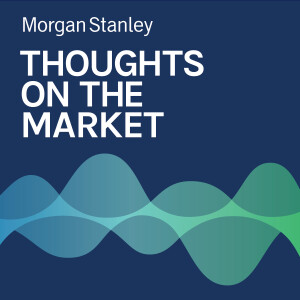
Vishy Tirupattur: Banking Regulations Could Reduce Available Credit
 2023-08-28
2023-08-28
Proposed regulations for smaller banks show that turmoil in the banking sector may still have an impact on the broader economy.
----- Transcript -----
Welcome to Thoughts on the Market. I am Vishy Tirupattur, Morgan Stanley's Chief Fixed Income Strategist. Along with my colleagues, bringing you a variety of perspectives, I'll be talking about the links between regulations and the real economy. It's Monday, August 28, at 11 a.m. in New York.
In the euphoria of buoyant equity markets over the last few months, the many challenges facing regional banks have receded into the background. While it certainly has not been our view, a narrative has clearly emerged that the issues in the sector that erupted in March are largely behind us. The ratings downgrades by both Moody's and Standard & Poor's of multiple U.S. banks in the last few weeks provide a reminder that the headwinds of increasing capital requirements, higher cost of funding and rising loan losses continue to challenge the business models of the regional banking sector.
The rating agency actions come on the heels of proposed rules to modify capital requirements for banks with total assets of 100 billion or more. Separately, the Fed has proposed a capital rule on implementing capital surcharge for the eight U.S. global systemically important banks. Further proposed regulations on new long term debt requirements for banks with assets of $100-700 billion are due to be announced tomorrow. It is early in the rulemaking process for all of these proposals. They may change after the comment period and the rules will be phased in over several years once they are finalized. Nevertheless, they outline the framework of the regulatory regime ahead of us.
While we won't go into the detailed discussion of thousands of pages of proposals here, suffice to say that the documents envisage significantly higher capital requirement for much of the U.S. banking sector, and extends several large bank requirements to much smaller banks. One such requirement pertains to the impact on capital of unrealized losses in available for sale securities. Currently, this provision applies only to Category one and Category two banks, that is banks with greater than $700 billion in total assets. But the proposal now expands it to Category three and Category four banks, that is banks with greater than $100 billion in total assets.
A recent paper from the San Francisco Fed shows how the regulatory framework of the banking system affects the real economy. Specifically, the paper demonstrates that banks, which experienced larger market value losses on their securities during the 2022 monetary tightening cycle extended less credit to firms. Given the experience of the last 18 months across fixed income markets, extending the impact of such mark-to-market losses to smaller banks, as is being proposed now, would exasperate the potential challenges to credit formation.
Against this background, we look at the near term prospects for bank lending. In the latest Senior Loan Officer Opinion survey, reflecting 2Q23 lending conditions, lending standards tightened across nearly all categories for the fourth consecutive quarter. Banks expect to tighten lending standards further across all categories through the year end, with the most tightening coming in commercial real estate, followed by credit card and commercial and industrial loans to small firms. The survey also asked banks to describe current lending standards relative to the midpoint of the standards since 2005. Most banks indicated the lending standards are tighter than the historical midpoint for all categories of commercial real estate and commercial and industrial loans to small firms.
The bottom line is that more tightening lies ahead for the broader economy. This survey shows how the evolution of regulatory policy can weigh on credit formation and overall economic growth. Given the disproportionate exposure of the regional banks to commercial real estate debt that needs to be refinanced, commercial real estate is likely to be the arena where pressure has become most evident, another reason why we are skeptical that the turmoil in the regional banking sector is behind us. While the proposed regulatory changes can open doors for non-bank lenders, such as private credit, it is important to note that such lending will likely come at higher cost.
Thanks for listening. If you enjoy the show, please leave us a review on Apple Podcasts and share Thoughts on the Market with a friend or colleague today.
More Episodes
 2024-03-25
2024-03-25
 2024-03-19
2024-03-19
 2024-03-18
2024-03-18
 2024-03-15
2024-03-15
 2024-03-13
2024-03-13
 2024-03-12
2024-03-12
 2024-03-11
2024-03-11
 2024-03-08
2024-03-08
 2024-03-06
2024-03-06
 2024-03-05
2024-03-05
 2024-03-04
2024-03-04
 2024-03-01
2024-03-01
 2024-03-01
2024-03-01
 2024-02-27
2024-02-27
Create your
podcast in
minutes
- Full-featured podcast site
- Unlimited storage and bandwidth
- Comprehensive podcast stats
- Distribute to Apple Podcasts, Spotify, and more
- Make money with your podcast
It is Free
- Privacy Policy
- Cookie Policy
- Terms of Use
- Consent Preferences
- Copyright © 2015-2024 Podbean.com




